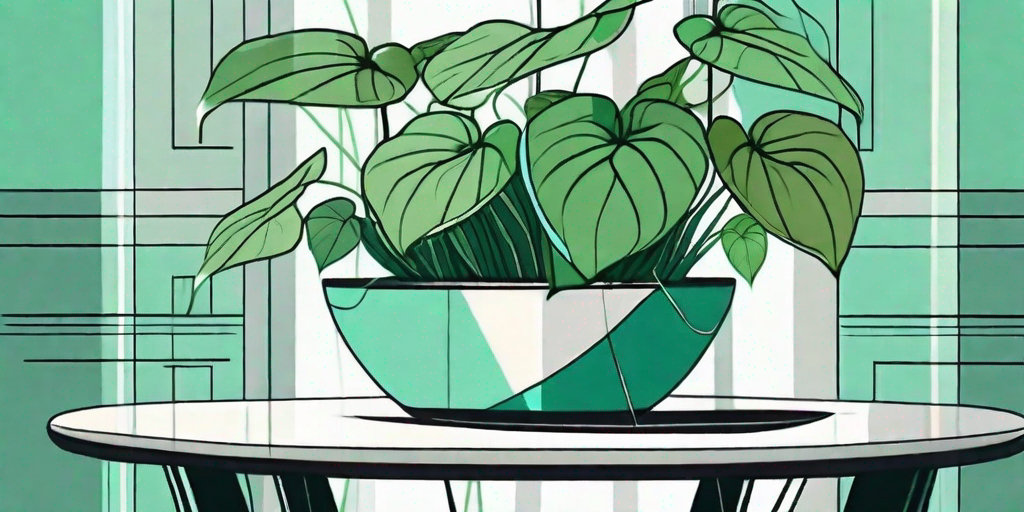
If you're looking for a houseplant that's as easy to care for as it is beautiful, look no further than the variegated pothos. This stunning plant, with its heart-shaped leaves and striking variegation, is a favorite among both novice and experienced gardeners. But don't let its beauty fool you - this plant is as tough as nails and can thrive in a wide range of conditions. So, whether you're a green thumb or a plant newbie, the variegated pothos is a perfect addition to your indoor garden.
Understanding the Variegated Pothos
What is a Variegated Pothos?
Before we dive into the nitty-gritty of caring for this plant, let's first understand what a variegated pothos is. The term 'variegated' refers to the plant's leaves, which feature a mix of green and white, cream, or yellow. This unique coloration is what gives the plant its stunning visual appeal. But the variegated pothos isn't just a pretty face - it's also a hardy plant that can withstand a variety of conditions, making it an excellent choice for those who are new to plant care.
Also known as Devil's Ivy or Golden Pothos, this plant is a native of the Solomon Islands but has since spread across the globe. It's a versatile plant that can be grown in hanging baskets, climbing up a trellis, or simply sitting on a shelf. No matter where you place it, the variegated pothos is sure to add a touch of beauty to your space.
The Benefits of Growing a Variegated Pothos
Aside from its aesthetic appeal, the variegated pothos also offers a host of benefits. For one, it's an excellent air purifier. According to NASA's Clean Air Study, the variegated pothos can remove toxins such as formaldehyde, xylene, and benzene from the air. So, not only does this plant beautify your space, but it also helps to keep your air clean and fresh.
Another benefit of the variegated pothos is its resilience. This plant can survive in low light conditions and is relatively drought-tolerant. So, even if you forget to water it for a week or two, don't worry - your pothos will likely bounce back with a bit of TLC.
How to Grow and Care for a Variegated Pothos
Light Requirements
When it comes to light, the variegated pothos is quite flexible. It can tolerate low light conditions, but for optimal growth and variegation, it prefers bright, indirect light. Be careful not to expose your plant to direct sunlight, as this can scorch the leaves and cause them to lose their variegation.
One way to ensure your plant gets the right amount of light is to place it near a north or east-facing window. If this isn't possible, you can also use artificial lights. Fluorescent lights, in particular, are a good option as they provide the right spectrum of light for photosynthesis.
Watering and Feeding
The variegated pothos is a bit of a camel when it comes to water - it can store it and use it when needed. This means you don't need to water it as frequently as other houseplants. In fact, overwatering can lead to root rot, which is one of the few things that can kill this hardy plant. A good rule of thumb is to let the top inch of soil dry out between waterings.
As for feeding, a balanced houseplant fertilizer applied every two to three months should do the trick. Just be sure to follow the package instructions to avoid over-fertilizing, which can lead to salt buildup in the soil.
Common Problems and Solutions
Yellow Leaves
If you notice your pothos' leaves turning yellow, this could be a sign of overwatering. As mentioned earlier, the variegated pothos doesn't like to have its feet wet. To remedy this, cut back on watering and ensure your plant has proper drainage.
Yellow leaves can also be a sign of insufficient light. If your plant isn't getting enough light, its variegation may fade, and its leaves may turn yellow. If this is the case, try moving your plant to a brighter location.
Brown Leaf Tips
Brown leaf tips are often a sign of low humidity or over-fertilization. If your home is particularly dry, try misting your plant or placing it on a tray of pebbles filled with water. If you suspect over-fertilization, flush the soil with water to remove excess salts and cut back on feeding.
FAQs
Is the variegated pothos toxic to pets?
Yes, the variegated pothos is toxic to both cats and dogs. If ingested, it can cause vomiting, irritation of the mouth, and difficulty swallowing. If you have pets, it's best to keep this plant out of their reach.
Can I propagate my variegated pothos?
Absolutely! Propagating a variegated pothos is a breeze. Simply cut a stem just below a node (the bump where a leaf attaches to the stem) and place it in water. In a few weeks, you should see roots starting to form. Once the roots are a few inches long, you can plant your cutting in soil.
Why is my variegated pothos losing its variegation?
If your variegated pothos is losing its variegation, it's likely not getting enough light. Try moving your plant to a brighter location, but avoid direct sunlight as this can scorch the leaves.
Conclusion
There you have it - a comprehensive guide to growing and caring for the variegated pothos. With its striking leaves and easy-care nature, this plant is a must-have for any indoor garden. So why wait? Unleash the beauty of the variegated pothos in your home today!















